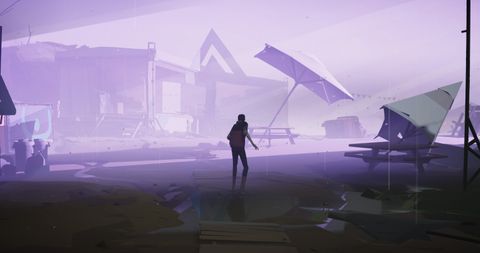Our Verdict
Somerville never hits its stride, thanks to flat direction and frustrating mechanics.
PC Gamer's got your back
What is it? A narrative-led platform puzzle game following a family's plight during an alien invasion of Earth.
Release date: November 15, 2022
Developer: Jumpship
Publisher: Jumpship
Reviewed on: RTX 2070, i7-10750H, 16GB RAM
Multiplayer? No
Link: Official site
The highlight of Somerville arrives just a few minutes in. A young family—man, woman, child, dog—living in a remote farmhouse awakes at night, having fallen asleep in front of the TV. You assume control of the man, head down to the basement to fetch the dog's food, and carry it up to the kitchen. Then boom. An explosion shakes the house and suddenly you're in the midst of an alien invasion.
It's an opening that recalls the drama of The War of the Worlds, as shards of red alien rock start raining from the sky like spears of lightning from Zeus. But from here Somerville soon reveals itself to be a War of the Worlds hobbled by flat direction, irritating puzzles, and no Tom Cruise. It takes an unconvincing turn immediately after the boom, where the obvious course of action is surely to race back to the basement and hunker down until the bombardment stops. Except the woman has decided you should make a run for the family car, and you have no choice but to follow. You exit the front door in time to see one of the shards slam down on the roof of your escape vehicle, writing it off in an instant. What now? That's right—hide in the basement.
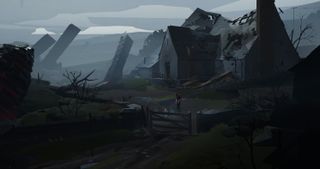
This isn't the only time in Somerville that you're faced with logic that isn't very logical. Since this is a puzzle-based adventure, progress is always based on discovering a specific solution, but those solutions tend to be fussy or unintuitive, and occasionally broken, which makes surviving this apocalypse a real bore. Take the next scene in the basement, for example. As the family cowers in the corner, some sort of alien craft smashes through the roof, and a blue-clad space pilot flops out of the cockpit, apparently dying. It reaches out a hand with its last breath, and your only option is to go and grab it, which really doesn't seem like a sensible thing to do. And then it takes a minute or so to find the exact spot the game wants you to stand to actually make that happen, which sucks all the tension from the situation.
Armed forces
You experience some kind of flashback or hallucination that knocks you out cold, and when you regain consciousness the woman and child are gone. At least the dog has stuck around. You also now have a special power—a puzzle MacGuffin on your arm lets you turn the hard red shards into a blue liquid when you channel its energy through a light source. So when you touch the nearby desk lamp, its beam now melts through the alien rock blocking the basement exit.
Later you'll receive another arm power that has the opposite effect—crystallising pools of the blue liquid into hard surfaces, again only when mediated through a light source—and together these yin-yang processes add up to a flexible concept, not to mention a reasonably impressive use of physics as the substances dissolve and solidify around features in the landscape. Some of the puzzles that emerge are also quite neat in design, like when you have to flood an area with liquid, then freeze it to create a new platform, or pull light sources on cords around obstacles.
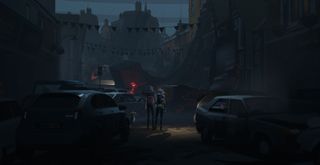
But as you and your canine companion traverse a devastated and deserted world, it's hard not to feel that Somerville could do with a few more ideas like this, even in its four to five-hour runtime, as there's not a great deal else here beyond pulling a few levers, handles and switches, and running away from some alien hunters. It's almost as though the calculations required to get the blue and red stuff to behave predictably has straitjacketed the level design, leaving you with so few ways of interacting with the environment that the main character comes across as lethargic and incapable. It's frustrating to see this healthy adult human refuse to work with the scenery in front of him—climbing over small obstacles, say, or picking up items that look useful—because the prescribed methods of progress are so limited.
Dead inside
Of course, plenty of narrative-led games make do just fine with pared back mechanics, but Somerville also falls short when it comes to its characters, story and cinematic pretensions. It creates an uphill struggle for itself from the off by trying to build its scenario without the use of spoken or written words, as games such as Playdead's Limbo and Inside have done to great effect in the past (Jumpship's founder Dino Patti was previously the founder of Playdead, and produced both games). What worked to evoke an eerie otherworldliness viewed through the eyes of a lone child, however, makes far less sense when dealing with a family in a recognisable reality. The absence of crying and screaming when the bombs start falling, for instance, feels strangely apathetic.
Sturdy support from the sound, animation and cinematography could have filled the gap here, but very little in Somerville's production really shines. Its camera plants itself at a cold distance from the action at all times, while sound effects are applied selectively, failing to convey impact or, say, the intimidating weight of a killer droid, and movement is stiffly conservative, as if trying to repress the emotional pressures of your journey. When the man gets hurt, for example, he simply spends the following scene clutching his stomach and coughing in a robotic loop—the only time you wish he was silent.
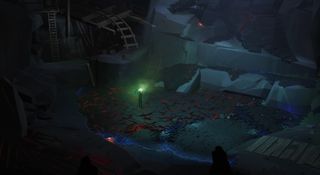
There's little indication throughout Somerville that it actually wants you to care about this man and his family. On occasions when he's separated from and then reunited with the dog, he scarcely acknowledges the poor creature's return. Or when you finally manage to deactivate one of the robot-alien things that chases you, there's no build-up of tension and no space provided to explore the man's relief or celebrate his victory before the next scene. One potentially powerful plot beat a little over halfway through the story, meanwhile, becomes unintentionally hilarious thanks to the dearth of affection on display.
Even one of the game's stronger features, its visual style, ultimately lacks any real dynamism. The game's eye for artistic composition is at its height in the first act, among depictions of silent rolling hills and fields, but the framing of urban streets and buildings later on is sometimes almost as striking. Yet even then many of the features within these landscapes—motorways strewn with empty cars, nearby patches of abandoned refugee tents—feel like stock images from any post-apocalyptic fiction. The longest single sequence in the game takes place in a grey mine where at best you might spot an interesting rock formation. Nor does Somerville use the 3D depth of its play area (an advantage it has over the likes of Inside) to toy with perspective for dramatic effect very often.
Bug hunt
Instead, the 3D depth of each scene is arguably Somerville's greatest blight. It's something of a novelty at first in a game like this to be able to walk around a car that's blocking your way, but this freedom quickly becomes a headache. As in that scene in the basement where you're trying to grab the pilot's hand, perspective often confounds your efforts to complete simple tasks. Trying to yank at a lever or a door handle can prove needlessly demanding, to the point you might decide you aren't supposed to interact with them after all. You then waste five minutes searching for another solution, before returning out of desperation and discovering you had the right answer all along, you just weren't quite aligned properly.
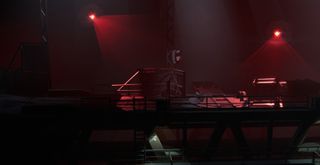
Somerville is packed with inconsistencies, such as a scene in a pool of water where you're arbitrarily limited to moving in a straight line, along with a deficit of clear visual communication that leads to tiresome trial and error, especially in do-or-die chase sequences. Various glitches also undermine your trust in its systems. If you're stumped somewhere, it may be because something's gone wrong, and you need to reload the section (or in one case reinstall the whole game). Items don't act the way they're supposed to, for example, or you get stuck in the floor. On one occasion, the action started running in slow motion, while on a few other physics-based puzzles suddenly clicked into place for no visible reason after initially refusing to work.
The final act of Somerville does at least take some mildly intriguing surreal turns, playing on the psychology of the main character to have you questioning what's real and what isn't. But on the back of such an arduous journey, it's too little too late, and that opening boom remains a promise that was never fulfilled. The only thing worth contemplating in the end is whether Somerville was an overambitious project that couldn't make good on a grand vision, or if it simply wasn't an inspired idea in the first place.
Somerville never hits its stride, thanks to flat direction and frustrating mechanics.
